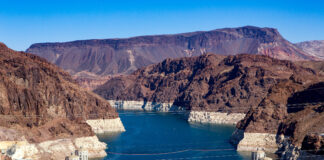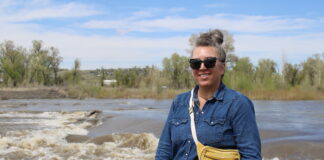
By Teressa Enriquez, AZ Luminaria, June 23, 2023
Jessica White glances up briefly at the sky. It’s barely 9 a.m. and the morning desert sun in May is gaining momentum.
Water Desk Grantee Publication
This story was supported by the Water Desk’s grants program.
Jessica makes sure her boys are drinking plenty of water and slathers sunscreen on all three of them. When she deems them ready, like a mother duck and her ducklings, the little group wades into the dry Santa Cruz River, along with the other volunteers. The group traverses the rocky and sandy bed in search of cleaner waterways.
The Santa Cruz River may be dry but on this spring morning it is alive with people who are making a seasonal river cleanup a community conservation tradition in Tucson.
The three little boys look at the river, puzzled about what happens next.
The sound of running water is replaced instead by that of the rustling of trash bags. The bike route above the river is filled with cyclists zooming by.

At 10 a.m. Luke Cole, the Sonoran Institute’s director for resilient communities and watersheds, stands atop the ramp that leads down to the Santa Cruz River. Cole looks like the intrepid wildlife explorers you would imagine as a child. His cowboy hat, bright, button up shirt and the teal and yellow handkerchief on his neck pair harmoniously with his white, clean-cut beard and mustache.
Through a bullhorn he makes an announcement: We’ve met our goal. Volunteers, you’ve collected 2,000 pounds of trash!
Cheers scatter the air as the message reaches everyone working along the snaking riverbed. The sun never lets up and, after a brief pause, neither do the volunteers. They continue cleaning, pulling, carrying and dragging trash out of the river before the event ends. This is their chance to clear out as much litter as they can before the monsoon season comes, and along with it a flowing river that carries more trash along connected Arizona waterways.
It’s 11 a.m. “Thank yous,” and “Good jobs,” shower down from the bike route as cyclists speed on by and notice the cleaner Santa Cruz River. With the cleanup complete, volunteers trudge their way up the ramp. They return all the supplies, the gloves, the trash grabbers and bags, back to Tucson Clean and Beautiful, a community partner that supplied all the tools used.
The river cleanup event was sponsored by Caterpillar and included partners from governmental agencies, like Tucson Clean and Beautiful and Pima Flood Control, and local ones, like Dragoon Brewing and food truck ViriViriBombBomb! An anonymous donor offered $1 for every pound of trash collected.
Standing together, the group eyes their day’s conservation work.
With about 70 volunteers, they helped collect almost 4,000 pounds of trash out of the Santa Cruz River in just 2 hours. This one stretch connects to miles and miles of Arizona waterways that experts say are critically endangered.

A river at risk
Due to climate change, overuse and outdated management, American Rivers, a nonprofit that advocates for protecting waterways, named the Colorado River the most endangered river of 2022.
The Colorado River is critical to “30 federally-recognized Tribal Nations, seven states, México and the drinking water for 40 million people,” the American Rivers report stated. “Also threatened is vital habitat for wildlife, as the Basin is home to 30 native fish species, two-thirds of which are threatened or endangered, and more than 400 bird species.”
The rivers and lakes connected to it, such as the Santa Cruz River, are also at risk. While water legislation and interstate drought plans are regularly changing, conservation experts argue that without movements in favor of cleaner habits, any efforts to expand water resources will suffer, as those resources become increasingly contaminated.
The institute had planned to host its first Santa Cruz River cleanup in 2020. But then COVID-19 hit and they had to cancel the event. So instead, the Sonoran Institute began working on a trash study with interns from the University of Arizona. The study was made to figure out what kind of trash was in the Santa Cruz River and where.
This analysis is vital information for the future of Tucson’s environmental policies.
They also started the #NotinmyRiver hashtag to make people aware of all the ways they can help by simply picking up trash in their neighborhood. Finally, in October of 2022, they hosted their first river cleanup. They’ve hosted two more since.

Michael Zellner is the Sonoran Institute’s CEO. In a February interview, Zellner advocated not only for the Santa Cruz River but for a change in perspective that incorporates more personal responsibility and collective community action in conservation efforts.
“For the past 100 years we have been protecting nature from human beings, parks and rivers. ‘Don’t touch it, leave it alone.’ But in the next 100 years what we are seeing is that we have to take care of natural resources for ourselves,” Zellner says. “If you look at it along the Colorado river and all the rivers like the Santa Cruz River, their water is running out. That phenomenon has to do with us, not with nature, and in fact nature will be alright. It will be us that suffer from our conduct.”
For conservationists, the growing worry of the Colorado River water crisis has been getting people more involved with their local bodies of water and pushing people to start asking: How can I be part of the solution?
Melissa Cordero is the Sonoran Institute’s marketing and communications manager. Cordero says they’ve seen a huge influx in community participation, including clicks on their social media pages and questions about how to get involved.
“I think it has a lot to do with our great turnouts to these kinds of events,” she says.
Getting kids involved
Jessica, the mom who took her three sons to the May river cleanup, is a respiratory therapist who works long hours. While she’s careful about how she manages her family’s time, Jessica saw volunteering as an opportunity to work collectively.
Unfortunately, the river being that dirty did not catch her family off guard.
“I live on the southwest side of Tucson near the Casino Del Sol and they’re just dumping trash pretty much everywhere – it just makes me really sad,” she says. “But I was happy that there was a group of people to do it. It’s hard to make a difference, one individual just doing something, so having a big group of people like that can be so impactful.”

Her boys got a kick out of volunteering.
“They were mostly excited that they got to wear a vest and some trash grabbers,” Jessica says, chuckling at the memory.
The Sonoran Institute works to hold events that are open to anyone, including families with children.
“As far as bringing my kids out there, I didn’t know how that was gonna turn out,” she says. “I didn’t know whether we would last 20 minutes and we would have to leave, but I thought it would be a good opportunity for them to kind of learn about looking outside of themselves.”
Jessica says she was not too environmentally conscious or active until 5 or 10 years ago. She wants her kids to start early.
“I really wanted to get them out and get them introduced to things outside of our little world early, so that they have a broader perspective,” she says. “And so they don’t grow up not wanting to get involved.”

We are one: Our river, our community and our change
The theme for the Sonoran Institute’s 2022 annual report was, “We are One.”
“It really is important when we are facing challenges like we are right now, when it comes to water conservation and restoration of these rivers, it’s not something just one organization can do,” Cordero says.
Successful outreach and turnout for events starts with collaboration, she says. The institute regularly interacts with organizations like the LGBTQ+ Chamber of Commerce, Watershed Management and Ward 1 and Ward 3.
The institute wants to change the outlook people have on volunteering and environmental activism. They want it to be fun.
“What we’re really trying to do is to set ourselves apart by incentivizing,” Cole says. “All these great local businesses are offering up gift certificates, are offering up bags of coffee and nice treats like that so that we can reward people for coming out here.”
They are also trying to bring out food trucks like ViriViriBombBomb. Dragoon Brewery gave all the river cleanup volunteers of drinking age a coupon for their first drink. “The last thing we want to do is have Tucson’s excited volunteer community get burnt out on cleaning the river,” says Cole.
Jessica appreciated that local businesses like 81 Barbershop and The Loft offered prizes but says internal motivation often outweighs incentives.
“I don’t think that a raffle is going to draw people out to the 90 degree weather to go clean up the river bed if they already don’t have the right intentions,” she says.

What a river says about its communities
It is vital to clean the river, even if the river does not always carry water, says Cole. Monsoon storms move water from various sources, especially through the downtown corridor of the Santa Cruz River.
“Getting that trash out of the river, even when the riverbed’s dry, at a minimum is us being good neighbors to Marana and other communities downstream where this trash would get washed down into,” Cole says. “Plus the Santa Cruz River is a wildlife corridor, you’re gonna want those beautiful animals to be using a river that isn’t full of trash.”
Cole says that because of the way Tucson is engineered all the water drains into the Santa Cruz River.
“It really genuinely makes a difference for you to clean up trash that you see when you’re walking around in your neighborhood because it will find its way to the Santa Cruz River,” Cole says. “Just throw it in the trash barrel and you’ll feel great for having done it and you’re benefiting the river by doing that too.”
Cole hopes the river cleanups can be done quarterly in coming years. There would initially be one in the spring, in the fall, in the winter and one right before the summer gets too hot and the monsoon season comes.
What you find in a river can say a lot about its city. Sometimes there are medical masks that flutter in bushes on the banks. Thirstbusters that stick out of the sand like trash hermit crabs or used needles that end up in the river bed.
On a good day, sometimes you will find volunteers dedicated to something bigger than themselves.
Glance into the Santa Cruz River on a hot May morning and you would find people ankle deep wrestling with old wet blankets clinging like cement to the moist sand. People walking around with milk gallons, collecting needles to correctly dispose of the hazardous waste.
People throwing faded, torn face masks, a signature pandemic symbol, and thinking back to a time when they could not come together like they did today.
You would see a mom guiding her three little boys, dressed in vests way too big for them, and gripping trash grabbers, working with a community conservation effort to remove nearly 4,000 pounds of trash out of the Santa Cruz River in just 2 hours.
How to get involved
The Sonoran Institute needs donations to further their research and outreach for projects in renewable resources, water conservation and sustaining natural resources. You can follow them on their Facebook, Instagram, YouTube, or Twitter and visit their website for upcoming events and volunteer opportunities.
This article first appeared on AZ Luminaria and is republished here under a Creative Commons license.
The Water Desk’s mission is to increase the volume, depth and power of journalism connected to Western water issues. We’re an initiative of the Center for Environmental Journalism at the University of Colorado Boulder.





